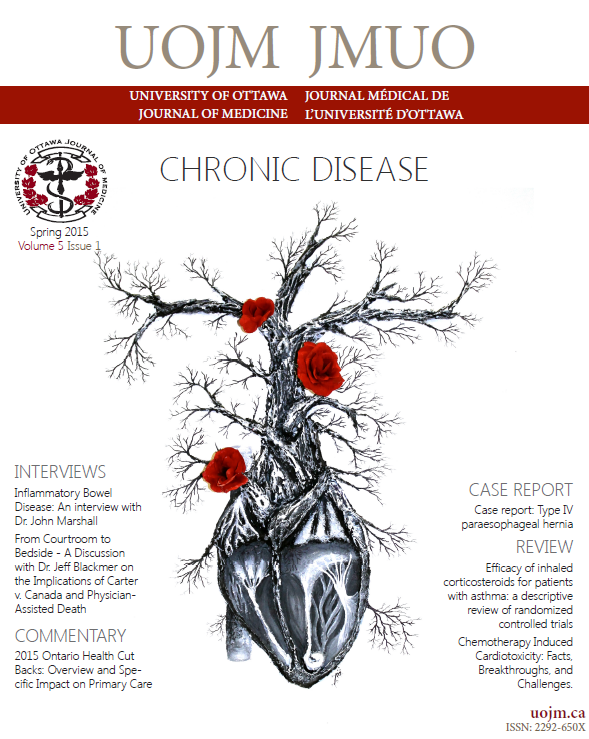Promoting physical activity in adolescent cancer survivors
DOI :
https://doi.org/10.18192/uojm.v5i1.1279Mots-clés :
physical activity, counselling, promotion, adolescent oncologyRésumé
Self-management strategies, such as physical activity, have been identified to help young cancer survivors reduce or control the side effects that accompany modern cancer therapies whilst improving their overall quality of life. Despite the known benefits of physical activity, the majority of young cancer survivors not meeting recommended guidelines. In this article, we discuss knowledge translation activities that are taking place across Canada to develop and disseminate resources to healthcare providers in an effort to improve physical activity counselling, and ultimately participation for adolescent cancer survivors.
Références
2. Ward E, DeSantis C, Robbins A, et al. Childhood and adolescent cancer statistics 2014. CA Cancer J Clin. 2014;64(2):83-103.
3. Children’s Oncology Group. Long-term follow-up guidelines for survivors of childhood, adolescent and young adult cancers, Version 4.0. Arcadia, CA: Children’s Oncology Group; 2013. p. 2
4. Hudson MM, Ness KK, Gurney JG, et al. Clinical ascertainment of health outcomes among adults treated for childhood cancer. JAMA. 2013;309(22):2371-81.
5. Mertens AC, Liu Q, Neglia JP, et al. Cause-specific late mortality among 5-year survivors of childhood cancer: the Childhood Cancer Survivor Study. J Natl Cancer Inst. 2008;100(19):1368-79.
6. McCorkle R, Ercolano E, Lazenby M, et al. Self-management: Enabling and empowering patients living with cancer as a chronic illness. CA Cancer J Clin. 2011;61(1):50-62.
7. Baumann FT, Bloch W, Beulertz J. Clinical exercise interventions in pediatric oncology: a systematic review. Pediatr Res. 2013;74(4):366-74.
8. Sabiston CM, Brunet, J. Reviewing the benefits of physical activity during cancer survivorship. Am J Lifestyle Med. 2012;6.
9. Winter C, Muller C, Hoffmann C, et al. Physical activity and childhood cancer. Pediatr Blood Cancer. 2010;54(4):501-10.
10. Badr H, Chandra J, Paxton RJ, et al. Health-related quality of life, lifestyle behaviors, and intervention preferences of survivors of childhood cancer. J Cancer Surviv. 2013;7(4):523-34.
11. Arroyave WD, Clipp EC, Miller PE, et al. Childhood cancer survivors' perceived barriers to improving exercise and dietary behaviors. Oncol Nurs Forum. 2008;35(1):121-30.
12. Hall AE, Boyes AW, Bowman J, et al. Young adult cancer survivors' psychosocial well-being: a cross-sectional study assessing quality of life, unmet needs, and health behaviors. Support Care Cancer. 2012;20(6):1333-41.
13. Wright M, Bryans A, Gray K, et al. Physical activity in adolescents following treatment for cancer: influencing factors. Leuk Res Treatment. 2013;2013:592395.
14. Orrow G, Kinmonth AL, Sanderson S, et al. Effectiveness of physical activity promotion based in primary care: systematic review and meta-analysis of randomised controlled trials. BMJ. 2012;344:e1389.
15. Santa Mina D, Alibhai SM, Matthew AG, et al. Exercise in clinical cancer care: a call to action and program development description. Curr Oncol. 2012;19(3):e136-44.
16. [Names withheld for peer-review]. Physical activity interventions to promote health and quality of life in adolescent cancer patients and survivors: A systematic literature review and suggestions for future research. In Preparation.
17. Canadian Cancer Society [Internet]. [place unknown]: Physical activity. [cited 2015 Mar 5]. Available from: http://www.cancer.ca/en/prevention-and-screening/live-well/nutrition-and-fitness/physical-activity/region=on.
18. Canadian Society for Exercise Physiology [Internet]. [place unknown]: Canadian physical activity guidelines [cited 2015 Mar 5]. Available from: http://www.csep.ca/english/view.aspx=949.
19. Schmitz KH, Courneya KS, Matthews C, et al. American College of Sports Medicine roundtable on exercise guidelines for cancer survivors. Med Sci Sports Exerc. 2010;42(7):1409-26.
20. Chamorro-Vina C, Keats, M., Culos-Reed, S.N. Pediatric oncology exercise manual, Version 1. Calgary, AB: Faculty of Kinesiology, University of Calgary, The Health and Wellness Lab; 2014.
Téléchargements
Publié-e
Numéro
Rubrique
Licence
- Les auteurs qui publient dans le JMUO gardent les droits d’auteur de leurs articles, incluant tous les brouillons et la copie finale publiée dans le journal
- Bien que le JMUO n’a pas les droits d’auteur des articles soumis, en acceptant de publier dans le JMUO, les auteurs donnent le droit au journal d’être les premiers à publier et à distribuer leurs articles.
- Par la suite, les auteurs peuvent soumettre leurs documents à d’autres publications, incluant des revues ou des livres, avec un remerciement de leur première publication dans le JMUO
- Des copies du JMUO seront distribuées à la fois sous format papier et en ligne, et tous les matériaux seront accessibles au public en ligne. Le journal n’a pas de responsabilité légale par rapport à la distribution publique du contenu.
- Prière de vous assurer que tous les auteurs, les coauteurs et les investigateurs
- Le contenu est rendu disponible sous licence Creative Commons Attribution - Pas d'Utilisation Commerciale - Pas de Modification 4.0 International.


